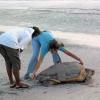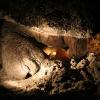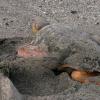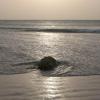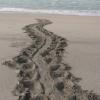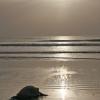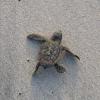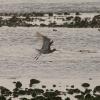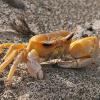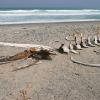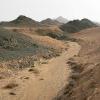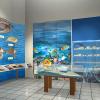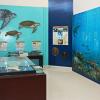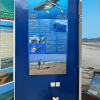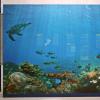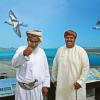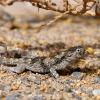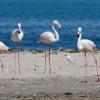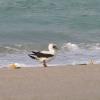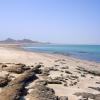Masirah Island
How protecting sea-turtles led to the creation of an Environmental Information Center.
By Nancy Papathanasopoulou
Masirah Island, tucked neatly against the eastern shore of Oman and the biggest island off the sultanate, is a wonder of nature. This Indian Ocean jewel hosts a number of fabulous sandy beaches where four species of sea turtles nest every year. Over 400 species of birds rest and eat (and some nest) in its endless mudflats, beaches, wadis and tiny offshore islets; and Masirah also has a small population of endemic gazelles; a large number of sea shells on the beaches and molluscs in the sea; and a pristine coral reef.
Inspired by all this ecological wealth and the need for better knowledge and protection in combination with forthcoming development, the Masirah Turtle Conservation Project (MTCP) began. Sponsored by Total Corporate Foundation for Biodiversity and the Sea and Total Oman, and under the auspices of the Directorate-General of the Ministry of Environment and Climate Affairs, MTCP was present on the island for three years, working with the expertise of Ipedex Productions and a group of researchers from different parts of the world. It was the first time that a private company of international importance such as Total cooperated with the Omani government and local authorities to produce a vast amount of data regarding the environment.
Developing the dream - Researchers on the island
For three years, experts on marine turtles, birds, reefs, molluscs, environmental education and institutions, legislation and sustainable development were coming and going every month to the villa rented by Total for MTCP. Their mission was to study Masirah’s environment and contribute to its protection and conservation, following the government’s growing strict policies on sustainable development in Oman.
Along with environmental educational packages for schools, quantities of scientific data about sea turtles and avifauna, and a proposal of a general management plan for sustainable development, the Total/Ipedex team delivered something else to Masirah: the first ever Environmental Information Center in Oman, inspired by the uniqueness of sea turtles and describing Masirah’s particular ecological wealth for everyone to see – locals, school children and lucky visitors.
Environmental Information Centers (EICs) were first developed in North America, where setting up and maintaining big museums was not always easy, particularly in the most remote areas. The purpose of EICs was to provide a constant, easily understandable and informative set of panels in order to present the particular environmental and cultural assets of the area, thus contributing to understanding, appreciation and conservation. The concept of the EIC has been further developed in Europe, especially in less affluent countries where large museums were not economically viable. Their success has been extraordinary and their contribution to environmental awareness and conservation through a relatively simple set-up is such that more EICs keep coming up everywhere, encouraged by private initiatives and governments.
Masirah’s museum - The centre explained
Designed by a team of Greek, German, Irish and English experts, the EIC of Masirah includes information on sea turtles at international, national and local levels; details on the birds, coral reefs, whales and dolphins of Masirah; and a display of 250 molluscs found on Masirah beaches, including the endemic, very rare to find ‘Eloise’ shell, which is exclusive to the island and is named after the wife of Dr Donald Bosch, an expert malacologist who has contributed wonders in gastropod and bivalve natural history in Arabia.
Set in a naturally sunlit central room in the new Masirah Municipality building, the EIC provides accessible information on everything. Its panels feature photos chosen from thousands taken by various project photographers and friends of the project. Text boxes and graphics have also been produced digitally in order to explain the movements of sea turtles in the region, based on information obtained by the first ten satellite transmitters on loggerhead turtles sponsored by Total in May 2006, as well as another ten attached by the Environment Society of Oman a few months later.
The sea and the sky - Birds, turtles, corals
Visitors to the EIC begin by getting to know Masirah and its people from the first introductory panel, ‘Masirah: a welcoming wonder of nature’. The text provides some details about local economic activities and ecology, and a tribute to the amazing hospitality of the population on the island.
Walking clockwise round the room, whales and dolphins encountered offshore Masirah are identified and briefly described. Cetaceans have been the object of long-term studies round the island by researchers from all over the world. The photo of an almost-complete baleen whale skeleton encountered in Ras Shiban beach is also displayed here, along with a real cetacean vertebrae found by researchers in Kalban beach three years ago.
Continuing to the left of the room, the visitor is greeted by a ‘flying’ crab plover over a magnificent beach and a greater flamingo ‘flying’ over a vast mudflat. Under these birds, three tables categorise and describe the avifauna on the island (birds in general, sea birds, waterfowl, birds of prey and so on), preparing the visitor for exploring outdoors with binoculars and camera in hand. There is much to excite birdwatchers on the island, especially during the autumn and winter months, when bird migration is at its peak in the region.
After the birds, it is the turn of the turtles, which are set to dominate the museum. Three-dimensional, almost life-size figurines of the leatherback, the loggerhead, the green, the Olive Ridley and the hawksbill turtle ‘float’ against a light blue background so that visitors can admire and compare the turtles’ similarities and differences. Information on all five species, the four nesting ones and the roaming leatherback in Masirah and in Oman is available on five individual wall panels, including maps with their main nesting sites, while two tables describe the life cycle, dangers and crucial role of the sea turtle for the world’s oceans and the planet itself.
After the turtles is a panel imitating the waters hosting the coral reef situated in the south of Masirah. The importance of coral reefs, their bleaching in many parts of the world and a description of the pristine, fully alive reef in Masirah dominate this panel. Visitors can explore the creatures that occupy the reef: turtles, anemone fish, corals, cuttlefish and many more are all identified. Exploring this panel feels almost like snorkelling.
A display of sea shells follows. Some 250 species of both bivalves and gastropods, all collected on the island and donated to the museum by a British long-time Masirah resident, Martyn Day, are carefully placed in five showcases, with labels containing scientific names and other data for each species. Situated on the wall among the showcases is a panel telling the story of molluscs and the importance of the khareef’s influence for them in Oman. Last of all, in the centre of the room, is a model map of the island indicating the beaches for turtles and birds and demonstrating the geomorphology of Masirah.
Opening night - Celebrating Masirah
To honour Oman’s first EIC, everyone was there for the inauguration last month on January 8: the Ministry of Environment and Climate Affairs with its director of biodiversity, Masirah-born Salim al Saadi, the Royal Air Force of Oman, which assisted project members with military flights, the director of Masirah Municipality, sheikhs and other local VIPs, and the representative of Total Oman, Jean-Claude Farina, and of Ipedex, Henri Crouhade. In their respective speeches, both Jean-Claude and Salim al Saadi stressed the importance of preserving Masirah’s ecological wealth for future generations and their contentment to see the EIC completed. All attendants were keenly interested in the EIC and some Masirah residents declared themselves proud to have ‘this little gem’ on their island for everyone to see.Masirah Island is there for everyone to discover. To ease this discovery, make sure you visit the EIC first. It will turn your visit into a much more knowledgeable and interesting one.

